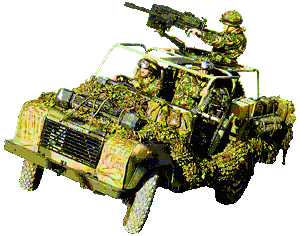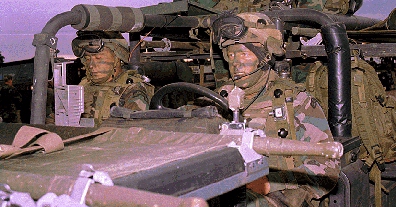
NO WAY OUT OF AFRICA?


NO WAY OUT OF AFRICA?

Thousands of miles away from the nearest beach or ocean, a friendly nation's Army is suddenly defeated by insurgents at a crucial battle using new technology weapons obtained from the world's arms market. The government forces crumble quickly unable to counter the surprise superiority gained by the rebels. American citizens are in trouble. There is no time to wait for ships to sail to the scene for an evacuation. They are told to grab their belongings and report to the international airport and wait for the U.S. Army's 75th Ranger Regiment to fly in by USAF MC-130 Combat Talons and rescue them. Noone is guarding the airport and other than an embassy Marine Security Guard (MSG) contingent, the Americans are at risk of being killed or taken hostage. The rebel Army is on the march and approaching the airport from 3 directions.
The approaching dusk is awakened by the drone of turboprop aircraft as parachutes fill the skies each with an armed-to-the-teeth Ranger light infantryman/Paratrooper. USAF A-10 jets strafe and bomb the areas around the airfield to clear them of any rebels but have to fly back to their base to refuel and re-arm. A single AC-130U Spectre gunship flying overhead is the only fire support available to the Rangers. Within minutes after they land they are met by criss-crossing tracer fire as the rebels meet them in a confused struggle as darkness covers the airfield. The Rangers and rebels are too close to have the Spectre fire, the Rangers need fire support now---their planes circling overhead have what they need. The American citizens and MSG contingent can only watch helplessly as men die to rescue them. A Combat Talon with Ranger Special Operations Vehicles (RSOVs) which are British Land Rover 4x4 jeeps with heavy machine guns and recoilless rifles slows down to make the first landing and hostage pick-up. On final approach, a rebel surface-to-air missile (SAM) hits the plane's leftmost engine and the plane skids across the runway and bursts into flames.
The runway is now blocked. There is no way out of Africa for the Rangers and the American hostages and Marines. Even worse, the sounds of rebel tanks are reported from the main roads leading to the airport which now cannot be blocked by Ranger RSOVs because they cannot be airlanded and some were destroyed in the crash. As day approaches, the AC-130U has to leave or it will be hit by rebel SAMs in daylight like Spirit 03 was in Desert Storm in 1990.
What do you do now, Ranger Lieutenant?
The first thing you do is NOT try to airland RSOVs in the first place. If your men came in by parachute--hopefully a good distance away from and not directly on top of a runway--their vehicle-level heavy fire support should also come by parachute---so it can be there when the fight is underway and not have to wait for the runway to be secured. Even with a runway secured from infantry direct-fire weapons there is no way to completely guarantee flight routes into and out from indirect fire weapons like shoulder SAMs---thus, it is premature and unwise to count on airlanding your vehicular fire support. Vehicular fire support will be needed to secure the airfield's surrounding area from shoulder SAMs and enemy vehicles and their direct-fire weapons. This mean RSOVs will need to be parachute low-velocity airdropped (LVAD) along with their Rangers onto drop zones AWAY FROM the obvious runway to seize an airfield.

If the 75th Rangers are insecure about losing their expensive RSOVs from routine LVAD exercises even though the 82nd Airborne Division airdrops and recovers its HMMWVs all the time--they can do notional RSOV airdrops and only actually airdrop RSOVs for major exercises. If there is a will there is a way; Rangers are supposed to lead the way. If other units can airdrop their vehicles certainly the Rangers should be able to do the same.
In fact, Major John Lock, U.S. Army writes in "To Fight with Intrepidity", page 489; a history of U.S. Army Rangers:
"The Airborne Force approached from north to south from over the Gulf of Panama, to be greeted by tracer rounds fired skyward. Despite the fires, three minutes after the initiation of the Stealth's attack, the green light of the lead C-130 came on and the first of 837 Rangers exited the blackened aircraft at 500 feet AGL--not all Rangers were able to exit on the pass with the DZ so tight. The anti-aircraft fires were heavy and, for the moment, unsuprressed as the spectre and helicopters had to cease fire and withdraw while the Paratroopers were in the air. Eleven of the thirteen pax transports were hit as they overflew the objective. The two heavy drop birds followed close behind to deliver their eight pallets loaded with jeeps, motorcycles and supplies"
So the Ranger Regiment HAS airdropped its vehicles in actual combat. Why this option isn't more vigorously pursued and planned for is a mystery.
Another option yet to be utilized by the Ranger Regiment is airlanding RSOVs from MH-47E Chinook helicopters from their rear ramps onto landing points far away from the obvious runway. The Special Operations Chinooks can be in-flight refueled to rendezvous with a fixed-wing Airdropped Ranger forces in MC-130s.
Now back to our situation in Africa....
Instead of the previously described airlanding, new T-21 personnel parachutes (reserve and main on the back) are jumped from just 250 feet (under enemy radar detection, tighter grouping of men on the ground, faster unit assembly) and selected Rangers run to their RSOVs on airdrop platforms and de-rig them. The RSOV's 40mm MK-19 GMGs are critical in mowing down rebel Soldiers and clearing the way for the Combat Talons to airland without risk of enemy fire. Road block teams in RSOVs and folding All/Extreme Terrain "Mountain" Bikes (jumped by individual Rangers in padded airdrop bags lowered on a line before landing) fan out to likely armored vehicle avenues of approach and wait with Javelin fire/forget ATGMs, M3 84mm RAAWs (Carl Gustav Recoilless rifles) and M136 AT4 rockets to destroy the coming rebel tanks and infantry fighting vehicles. The first flight of Americans and injured Rangers are flown away on Combat Talons and other C-130 Hercules aircraft as the enemy armor gets devastated by the Rangers lying in ambush.
But all is not well...
The rebels change their tactics and decide to close the runway down Dien Bien Phu-style by pummeling the Rangers and any aircraft trying to airland in the open with mortars and artillery pieces. Unarmored RSOVs are turned into flaming wreck; more Rangers are killed and wounded which require immediate medical evacuation.
What do you do now, Ranger Battalion Commander?
The solution is to realize like the Israeli Defense Force Paratroopers did for the Entebbe Rescue in 1976---to bring your own 11-ton M113 Gavin-type light tracked armored fighting vehicles (AFVs) to the fight. LVAD M1064 variant M113A3s with 120mm mortars (7200 meter range, excellent urban combat penetration/destructive effects) to be the Ranger Regiment's "hip pocket" artillery with precision guided mortar rounds to suppress enemies for quick, small scale rescues. Another option is obtaining German 3 ton Wiesel or reduced-size M113 "Mini-Gavin" tracked AFVs which are easily carried inside CH-47 type Chinook helicopters 2 at a time for AIRmechanized capabilities. Wiesel variants can carry troops or 120mm mortars. The mortar M113A3 Mini-Gavins or Wiesels could operate under armor protection or ground mounted to free the vehicle's insides to shuttle Rangers forward against stubborn enemy positions with protection from small arms fire, artillery and mortar bursts and give 10-40 mph mobility across open airfields. Having M113A3s organic to the Ranger Regiment would insure it never has to rely on outsiders for armored protection as the tragic events in Somalia proved.
Back to the Rangers surrounded at the airport....
Upon the first enemy shells landing onto the airport, the Ranger Battalion commander ordered the remaining C-130s to wait and his Rangers to take cover using the new FPOCs. He ordered his Ranger Armored Mortar Vehicles (RAM-Vs) to engage the rebel firing systems via targeting data relayed from an unmanned aerial vehicle overflying the battle area. The rebel guns are silenced and the Hercules aircraft land to pick-up the last of the Rangers and the surviving RSOVs, RAM-Vs for the flight back to safety.
The next day, the rebel army over-ran the international airport.
CONCLUSIONS
Its obvious that in larger airfields more heavily defended---that a Brigade or even all 3 Brigades of the 82nd Airborne Division's Paratroopers will be needed to secure a large enough area to free aircraft to airland free from enemy air defense, artillery and direct fire weapons. The XVIII Airborne Corps Artillery also has the fire-finding radars and long range tube (105mm, 155mm) and rocket/missile artillery systems (HIMARS, EFOGM) to silence long-range enemy indirect fire weapons of enemy units larger than what a Ranger Battalion could be expected to prevail against. The best way to do this would be by landing away from the defended runways themselves and converge on them from multiple drop zones using an 82nd Airborne Division Paratrooper force equipped with M113A3 Gavins AFVs to act as armored personnel carriers like the Russian Airborne does with its 8-ton BMD family of light armored fighting vehicles.
 www.youtube.com/watch?v=EUYv79GCt9s
www.youtube.com/watch?v=EUYv79GCt9s
If the 75th Ranger Regiment is going to replace its RSOVs, it should replace them with a tracked, light AFV like the M113A3 Gavin which is sturdy, rugged, reliable, swims, is easy to maintain and can be air-dropped without fear of it being broken because its in essence an armored box on tracks. The M113A3 will not be turned into a flaming wreck by a mere burst of enemy small arms fire or lucky nearby burst of mortar/artillery fire. If you are going to "force an entry" expect the enemy to shoot back and resist you, this means being able to be resilient against this fire, not overcome by it.
Airborne!
RETURN TO U.S. ARMY AIRBORNE EQUIPMENT SHOP